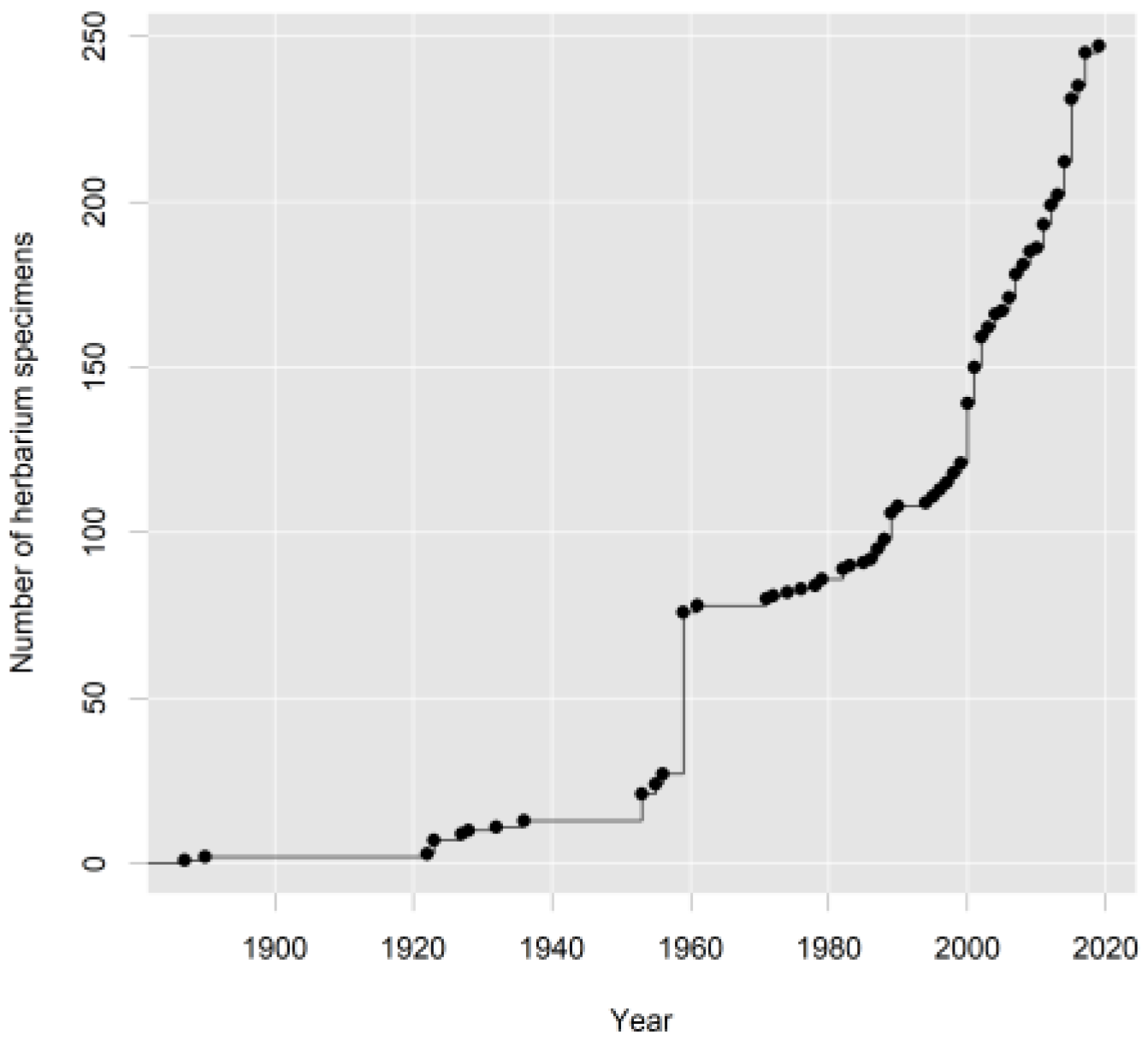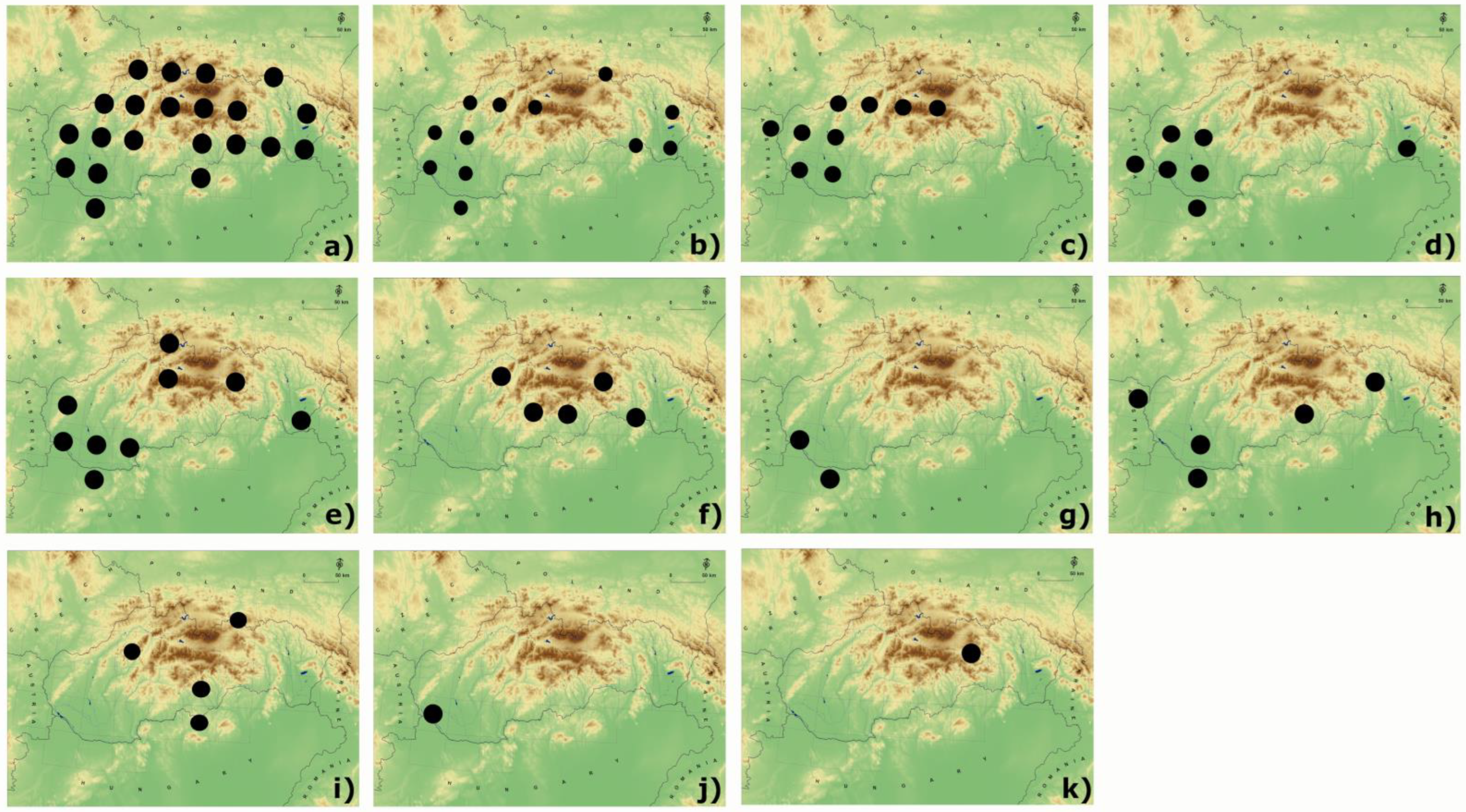Checklist, Red List, and Distribution Pattern of Charophytes (Charophyceae, Charales) in Slovakia Based on Critical Revision of Herbarium Specimens
Abstract
1. Introduction
2. Materials and Methods
3. Results
3.1. Revision of Herbarium Specimens, Checklist, and Distribution Pattern of Charophytes
3.2. Red List of Charophytes
4. Discussion
4.1. Changes in Lists of Charophytes
4.2. Comments to Newly Recognized and Undetermined Species in Slovakia
4.3. Comments to Critically Endangered and Some Regional Extinct Species
4.4. Threat Status of the Stoneworts in Slovakia: Comparison of Previous and New Red Lists
Author Contributions
Funding
Institutional Review Board Statement
Data Availability Statement
Acknowledgments
Conflicts of Interest
References
- McCourt, R.M.; Karol, K.G.; Guerlesquin, M.; Feist, M. Phylogeny of extant genera in the family Characeae (Charales, Charophyceae) based on rcbL sequences and morphology. Am. J. Bot. 1996, 83, 125–131. [Google Scholar] [CrossRef]
- Caisová, L.; Gąbka, M. Charophytes (Characeae, Charophyta) in the Czech Republic: Taxonomy, autecology and distribution. Fottea 2009, 9, 1–43. [Google Scholar] [CrossRef]
- Guiry, M.D.; Guiry, G.M. AlgaeBase. World-Wide Electronic Publication; National University of Ireland: Galway, Ireland, 2022; Available online: https://www.algaebase.org (accessed on 15 September 2022).
- Wood, R.D.; Imahori, K. Geographical Distribution of Characeae. Bull. Torrey Bot. Club 1965, 86, 172–183. [Google Scholar] [CrossRef]
- Krause, W. Charales (Charophyceae). In Süsswasserflora von Mitteleuropa 18; Ettl, H., Gärtner, G., Heynig, H., Mollenhauer, D., Eds.; Gustav Fischer Verlag: Jena, Germany, 1997; pp. 1–102. [Google Scholar]
- Blaženčić, J.; Stevanović, B.; Blaženčić, Ž.; Stevanović, V. Red data list of Charophytes in the Balkans. Biodivers. Conserv. 2006, 15, 3445–3457. [Google Scholar] [CrossRef]
- Arbeitsgruppe Characeen Deutschlands Hrsg. Armleuchteralgen. Die Characeen Deutschlands; Springer Spektrum: Rostock, Germany, 2016; p. 618. [Google Scholar]
- Stewart, N.F.; Hatton-Ellis, T.W. Red Data Books of Britain and Ireland: Stoneworts; Joint Nature Conservation Committee: Peterborough, UK, 1993; p. 144. [Google Scholar]
- Simons, J.; Nat, E. Past and present distribution of stoneworts (Characeae) in the Netherlands. Hydrobiologia 1996, 340, 127–135. [Google Scholar] [CrossRef]
- Langangen, A. Charophytes of the Nordic Countries; Saeculum ANS: Oslo, Norway, 2007; p. 102. [Google Scholar]
- Urbaniak, J.; Gąbka, M. Polish Charophytes: An illustrated Guide to Identification; Uniwersytet Przyrodniczy we Wrocławiu: Wrocław, Poland, 2014; p. 120. [Google Scholar]
- Vesić, A.; Blaženčić, J.; Šinžar-Sekulić, J. Contribution to knowledge of the charophytes (Charales) of Vojvodina (Serbia)—20 years after the first review. Botanica Serbica 2016, 40, 237–247. [Google Scholar]
- Romanov, R.E.; Patova, E.N.; Teteryuk, B.Y.; Chemeris, E.V. Charophytes (Charales, Charophyceae) on the northeastern edge of Europe: Is it something diff erent across Northern Europe in their diversity and biogeography? Nova Hedwigia 2018, 147, 161–182. [Google Scholar] [CrossRef]
- Hrafnsdottir, T.; Ingimarsson, F.; Ingvason, H.R.; Stefánsson, S.M.; Porvaldsdóttir, E.G.; Hilmar, J.; Malmquist, H.J.; Langangen, A. New finds of charophytes in Iceland with an update on the distribution of the charophyte flora. Nord. J. Bot. 2019, 37, e02111. [Google Scholar] [CrossRef]
- Mouronval, J.B.; Baoudouin, S.; Borel, N.; Soulié-Märche, I.; Grillas, P. Guide des Characees de France Mediterraneenne; Office National de la Chasse et de la Faune Sauvage: Paris, France, 2015; p. 211. [Google Scholar]
- Blaženčić, J.; Stevanović, B.; Blaženčić, Ž.; Stevanović, V. Distribution and ecology of charophytes recorded in the West and Central Balkans. Cryptogam. Algol. 2006, 27, 311–322. [Google Scholar]
- Schneider, S.C.; García, A.; Martín-Closas, C.; Chivas, A.R. The role of charophytes (Charales) in past and present environments: An overview. Aquatic Botany 2015, 120 Pt A, 2–6. [Google Scholar] [CrossRef]
- Rey-Boissezon, A.; Auderset Joye, D. Habitat requirements of charophytes –evidence of species discrimination through distribution analysis. Aquatic Botany 2015, 120 Pt A, 84–91. [Google Scholar] [CrossRef]
- Torn, K.; Kovtun-Kante, A.; Herkül, K.; Martin, G.; Mäemets, H. Distribution and predictive occurrence model of charophytes in Estonian waters. Aquatic Botany 2015, 120 Pt A, 142–149. [Google Scholar] [CrossRef]
- Vesić, A.; Blaženčić, J.; Šinžar-Sekulić, J. Ecological preferences of charophytes in Serbia in relation to habitat type and other aquatic macrophytes. Plant Biosystems 2016, 150, 490–500. [Google Scholar] [CrossRef]
- Palamar-Mordvintseva, G.M. Red List of Charales of the Ukraine. Int. J. Algae 2004, 1, 95–150. [Google Scholar] [CrossRef]
- Stewart, N.F.; Church, J.M. A Red List of Stoneworts in Wales. NRW Evidence Report No: 406; Natural Resources Wales: Bangor, UK, 2020; p. 105. [Google Scholar]
- Hindák, F.; Kováčik, Ľ. Súpis siníc a rias Tatranského národného parku. Zborník TANAP 1993, 33, 235–279. [Google Scholar]
- Husák, Š. Parožnatky (Charophyta) v Mělkých Vodních Ekosystémech ČSSR; Zborník VII. Konferencie Československej Limnologickej Společnosti: Nitra, Slovakia, 1985; pp. 165–168. [Google Scholar]
- Oťaheľová, H.; Husák, Š. Vegetácia odvodňovacích kanálov v okolí Gabčíkova—Slané jazero. OchranaPrírody 1992, 1, 95–105. [Google Scholar]
- Hrivnák, R.; Oťaheľová, H.; Husák, Š. Nitella mucronata and N. translucens—Contribution to occurrence and ecology in Slovakia. Biologia 2001, 56, 13–15. [Google Scholar]
- Oťaheľová, H. Charetea Fragilis. In Rastlinné spoločenstvá Slovenska 3. Vegetácia Mokradí; Valachovič, M., Ed.; Veda: Bratislava, Slovakia, 2001; pp. 393–406. [Google Scholar]
- Malovcová-Staníková, M. Nová lokalita asociácie Charetum hispidae Margelof 1947 v blízkom okolí Hlohovca. Acta Rerum Nat. 2003, 49, 52–54. [Google Scholar]
- Jursa, M.; Oťaheľová, H. The distribution of aquatic macrophytes in man-modified water-bodies of the Danube river in Bratislava region (Slovakia). Ekológia 2005, 24, 368–384. [Google Scholar]
- Hrivnák, R.; Bubíková, K.; Oťaheľová, H.; Šumberová, K. Formalised classification of aquatic vegetation in Slovakia. Phytocoenologia 2019, 49, 107–133. [Google Scholar]
- Hindák, F.; Hindáková, A. Sinice a Riasy. Cyanophytes/Cyanobacteria and Algae. In Zoznam Nižších a Vyšších Rastlín Slovenska; Marhold, K., Hindák, F., Eds.; Veda: Bratislava, Slovakia, 1998; pp. 11–100. [Google Scholar]
- Hindák, F.; Hindáková, A. Červený zoznam siníc/cyanobaktérií a rias Slovenska. 2. verzia (December 2001). Ochrana Prírody 2001, 20, 14–22. [Google Scholar]
- IUCN. Red List Categories and Criteria: Version 3.1., 2nd ed.; IUCN: Gland, Switzerland; Cambridge, UK, 2012; p. 32. [Google Scholar]
- IUCN. Guidelines for Application of IUCN Red List Criteria at Regional and National Levels: Version 4.0; IUCN: Gland, Switzerland; Cambridge, UK, 2012; p. 41. [Google Scholar]
- IUCN. Guidelines for Using the IUCN Red List Categories and Criteria. Version 15.1; Standards and Petitions Subcommitteeof the IUCN Species Survival Commission: Brussels, Belgium, 2022; p. 114. [Google Scholar]
- Lhotský, O.; Rosa, K.; Hindák, F. Súpis Siníc a Rias Slovenska; Veda: Bratislava, Slovakia, 1974; pp. 1–202. [Google Scholar]
- Valachovič, M. Rastlinné Spoločenstvá Slovenska 3. Vegetácia Mokradí; Veda: Bratislava, Slovakia, 1995; pp. 1–435. [Google Scholar]
- Stanová, V.; Valachovič, M. Katalóg Biotopov Slovenska; Daphne—Inštitút aplikovanej ekológie: Bratislava, Slovakia, 2002; p. 225. [Google Scholar]
- Hindáková, A.; Gąbka, M. Let’s Chat about Chara canescens Loiseleur 1810. In Proceedings of the 39th International Conference of the Polish Phycological Society "Contemporary Taxonomy of Algae"; Wydawnictwo Uniwersytetu Gdańskiego: Sopot, Poland, 2021; p. 42. [Google Scholar]
- Gąbka, M. Charophytes of the Wielkopolska Region (NW Poland): Distribution, Taxonomy and Autecology; Bogucki Wydawnictwo Naukowe: Poznań, Poland, 2009; p. 110. [Google Scholar]
- Hindák, F. Cyanobaktérie/Sinice a Riasy. In Ochrana Flóry v Slovenskej Republike; Maglocký, Š., Ed.; PrírodovedeckáFakulta UK; Bratislava& SlovenskáPoľnohospodárskaUniverzita: Nitra, Slovakia, 2000; pp. 9–19. [Google Scholar]
- Kotlaba, F. Červená Kniha Ohrozených a Vzácnych Druhov Rastlín a Živočíchov SR a ČR, 4.diel, Sinice a Riasy, Huby, Lišajníky, Machorasty; Príroda: Bratislava, Slovakia, 1995; pp. 1–223. [Google Scholar]



| Species Name | No. sp. | No. gc. | IUCN Category |
|---|---|---|---|
| 1,2Chara vulgaris Linnaeus 1753 | 115 | 21 | NT |
| 1,2Chara globularis Thuiller 1799 | 42 | 12 | NT |
| 1,2Chara contraria A.Braun ex Kützing 1845 | 27 | 9 | VU (B2c, C2b) |
| 1,2Chara hispida Linnaeus 1753 | 23 | 7 | VU (B2c, C2b) |
| Chara virgata Kützing 1834 | 15 | 9 | VU (B2c, C2b) |
| 1Chara gymnophylla A.Braun 1835 | 8 | 5 | VU (B2a,c, C2b) |
| 1,2Nitellopsis obtusa (N.A.Desvaux) J.Groves 1919 | 7 | 2 | EN (B2a,c; C2ai,b) |
| 2Nitella mucronata (A.Braun) F.Miquel in H.C.Hall 1840 | 6 | 5 | EN (B2a,c; C2ai,b) |
| 2Chara braunii C.C.Gmelin 1826 | 4 | 4 | EN (B2a,c; C2ai,b) |
| 1Nitella gracilis (J.E.Smith) C.Agardh 1824 | 3 | 2 | RE |
| 1Chara subspinosa Ruprecht 1846 (=Chara rudis (A.Braun) Leonhardi 1863) | 2 | 1 | RE |
| 1,2Nitella flexilis (Linnaeus) C.Agardh 1824 | 2 | 2 | RE |
| 1,2Nitella syncarpa (J.L.Thuillier) Kützing 1845 | 2 | 1 | EN (B2a,c; C2ai,b) |
| Nitella capillaris (A.J.Krocker) J.Groves and G.R.Bullock-Webster 1920 | 2 | 2 | RE |
| 1,2Chara canescens Loiseleur 1810 | 1 | 1 | CR (B1a, 2a) |
| Chara connivens P.Salzmann ex A.Braun 1835 | 1 | 1 | RE |
| 2Nitella confervacea (Brébisson) A.Braun ex Leonhardi 1863 | 1 | 1 | RE |
| 1,2Nitella opaca (C.Agardh ex Bruzelius) C.Agardh 1824 | 1 | 1 | RE |
| 1,2Chara aspera Willdenow 1809 | . | . | DD |
Publisher’s Note: MDPI stays neutral with regard to jurisdictional claims in published maps and institutional affiliations. |
© 2022 by the authors. Licensee MDPI, Basel, Switzerland. This article is an open access article distributed under the terms and conditions of the Creative Commons Attribution (CC BY) license (https://creativecommons.org/licenses/by/4.0/).
Share and Cite
Hindáková, A.; Gąbka, M.; Hrivnák, R. Checklist, Red List, and Distribution Pattern of Charophytes (Charophyceae, Charales) in Slovakia Based on Critical Revision of Herbarium Specimens. Diversity 2022, 14, 897. https://doi.org/10.3390/d14110897
Hindáková A, Gąbka M, Hrivnák R. Checklist, Red List, and Distribution Pattern of Charophytes (Charophyceae, Charales) in Slovakia Based on Critical Revision of Herbarium Specimens. Diversity. 2022; 14(11):897. https://doi.org/10.3390/d14110897
Chicago/Turabian StyleHindáková, Alica, Maciej Gąbka, and Richard Hrivnák. 2022. "Checklist, Red List, and Distribution Pattern of Charophytes (Charophyceae, Charales) in Slovakia Based on Critical Revision of Herbarium Specimens" Diversity 14, no. 11: 897. https://doi.org/10.3390/d14110897
APA StyleHindáková, A., Gąbka, M., & Hrivnák, R. (2022). Checklist, Red List, and Distribution Pattern of Charophytes (Charophyceae, Charales) in Slovakia Based on Critical Revision of Herbarium Specimens. Diversity, 14(11), 897. https://doi.org/10.3390/d14110897










